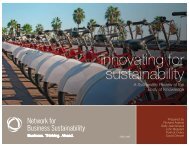Case Study - Network for Business Sustainability
Case Study - Network for Business Sustainability
Case Study - Network for Business Sustainability
Create successful ePaper yourself
Turn your PDF publications into a flip-book with our unique Google optimized e-Paper software.
Engaging the Community: A Knowledge Project<br />
Industry Self-Regulation<br />
By the early 1970s researchers suspected that noise from vessels was negatively affecting killer whales.<br />
There<strong>for</strong>e, they developed an unofficial code of conduct while working around whales. Subsequently,<br />
growing public interest in killer whales led to an increasing concern by the developing whale watching<br />
industry, NGO environmental groups, and the scientific community, especially given a lack of sufficient<br />
regulations by American and Canadian governments.<br />
In 1988 The Whale Museum in Friday Harbor, WA initiated a community-based adaptive management<br />
process <strong>for</strong> generating voluntary best practices <strong>for</strong> wildlife viewing that supported and enhanced the<br />
federal guidelines in each country. These guidelines set out specific vessel distances, vessel speeds, and<br />
the orientation of vessels relative to whales <strong>for</strong> viewing and approach practices <strong>for</strong> commercial<br />
operators. They also included matters that were not addressed by the U.S. Marine Mammal Protection<br />
Act and the Canadian Fisheries Act regulations which merely prohibited the harassment of whales.<br />
Since the development of the guidelines, the international WWOANW, to which most operators in<br />
southern British Columbia belong, has been one of the most important ways <strong>for</strong> the industry to provide<br />
in<strong>for</strong>mation about whale watching to the public and to regulate themselves in the absence of<br />
government legislation. The Best Practices Guidelines are seen as “the most comprehensive and<br />
detailed whale watching guidelines in the world” (Malcolm, 2003, p. 94). See Appendix <strong>for</strong> the 2006<br />
WWOANW Best Practices Guidelines.<br />
Each year WWOANW holds membership meetings to discuss current issues and to adopt a new set of<br />
working guidelines to meet changing cetacean and human use conditions. The WWOANW consults with<br />
community groups such as the Whale Museum in Friday Harbor, WA, commercial tour operators, local<br />
residents, and regional scientists. At annual meetings the members are updated on guideline changes,<br />
new scientific findings on potential whale impacts, and other in<strong>for</strong>mation. Recommendations from<br />
these sources often result in adjustments to the Best Practices Guidelines. The Association also holds<br />
international driver trainings each spring to keep drivers updated on guideline changes, and in the case<br />
of new drivers to educate them on the Best Practices Guidelines.<br />
In 1993, due to the lack of government en<strong>for</strong>cement, The Whale Museum in Friday Harbor, WA began<br />
operating the Soundwatch Boater Education Program (“Soundwatch”) in the boundary waters of the<br />
southern Vancouver Island and the San Juan Islands of Washington State. This area is the busiest killer<br />
whale watching region in the world. Soundwatch began distributing whale watching in<strong>for</strong>mation and<br />
viewing guidelines to recreational boaters from patrol vessels operating in the area. Soundwatch has<br />
also provided Feedback Reports to WWOANW members concerning individual vessels that are piloted in<br />
ways that are contrary to the guidelines. The Feedback Reports are intended to help drivers improve<br />
their behaviour and to provide a basis <strong>for</strong> evaluating the effectiveness of the current guidelines. This<br />
program has operated mainly on the basis of private grants with some additional funding given<br />
inconsistently by WWOANW and the 2002 Canadian Marine Mammal Monitoring Project (M3). M3 is<br />
presently managed by the Veins of Life Watershed Society, a non-profit organization from Victoria, BC<br />
8
















